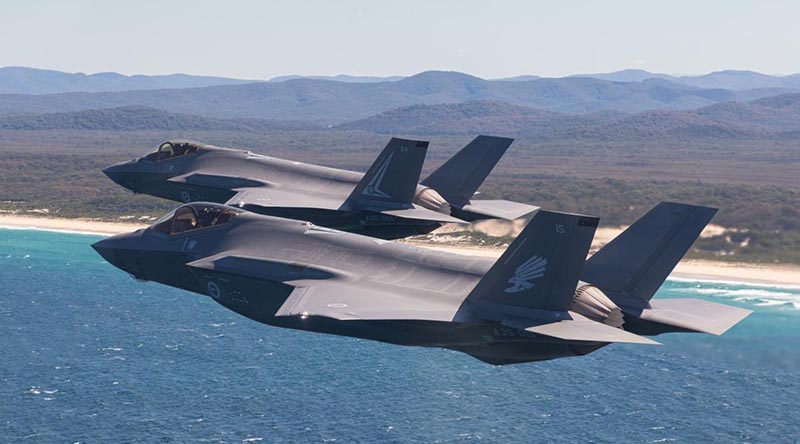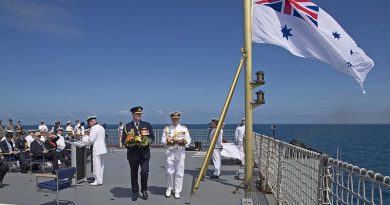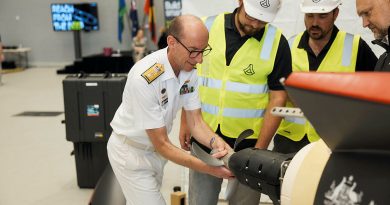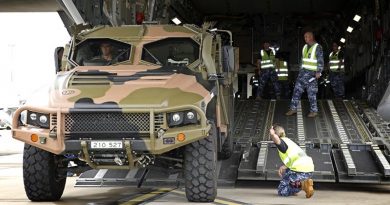Former CAF says RAAF seriously deficient

“The Royal Australian Air Force must acquire a long-range strike bomber to fill a critical capability gap and enhance the nation’s defence”, says retired Chief of Air Force Air Marshal Geoff Brown, now on RSL Australia’s Defence and National Security Committee.
FILE PHOTO: F-35A Lightning II aircraft fly in formation along the Newcastle-region coast in NSW during Exercise Lightning Storm. Photo by Sergeant David Gibbs.
Air Marshal Brown says the absence of a dedicated long-range bomber aircraft, integrated Air and Missile Defence and a robust fighter capability are critical gaps in the RAAF’s arsenal, particularly considering emerging security challenges in Australia’s region.
“It is a deficiency that the incoming government must address as a priority.”
In a paper for the Returned & Services League of Australia’s Defence and National Security Committee titled, The Royal Australian Air Force (RAAF) – Unrealised Potential, Air Marshal Brown says in a world where adversaries are rapidly advancing their missile and defence capabilities, the ability for Australia to conduct deep-strike operations and robustly defend our bases are no longer luxuries, they are a strategic imperative.
“A long-range bomber would not only extend Australia’s offensive reach but also complement existing platforms, ensuring that the nation’s air power remains robust, flexible and capable of meeting future challenges head-on.
“Committing to purchase a long-range bomber fleet is in line with the RSL’s push for the incoming government to develop a balanced Australian Defence Force and increase defence spending up to three percent of GDP within 12 months.
“The RAAF is widely recognised as a modern, technologically advanced air force, underpinning Australia’s national security and regional influence.
“Yet, growing regional military power and increasing competition, together with Australia’s traditional mismatch between geography and resources, highlight deficiencies that constrain the RAAF’s reach, stamina and hardiness.
“Australia should strengthen the RAAF to address these gaps to bolster the ADF’s ability to strike powerfully at very long ranges.
“Acquiring a long-range bomber is the critical first step.”
Air Marshal Brown said that, ultimately, the RAAF’s future success depended on an holistic approach that bridged current deficiencies through targeted investments in technology, logistics and human capital.
“To maintain its aerial dominance and address existing deficiencies, the RAAF must adopt a forward-looking strategy built on several pillars, with the acquisition of long-range strike capability being paramount.
“It must increase the number of combat and support aircraft and continue to modernise the current fleet.
“It must strengthen its intelligence, surveillance and reconnaissance (ISR) as well as electronic-warfare-countermeasure systems and expand tactical unmanned aerial vehicle resources.
“The RAAF must develop a robust logistics and supply chain and develop its human capital.
“Tackling recruitment, training and retention challenges is essential through training programs, coupled with incentives to retain experienced pilots and technicians.
“Investments in multi-domain command structures, integrating cyber, space and conventional air operations into a unified doctrine is imperative and joint exercises with allied forces will foster interoperability and resilience.”
Air Marshal Brown said that as the threat landscape evolved, the RAAF must continue to adapt, innovate and invest in a comprehensive, interdependent force structure that secures Australia’s strategic interests in an increasingly contested global arena.
“The RSL, with our service personnel, veterans and the community will be looking to the incoming Australian government to address the RAAF’s systemic gaps in concert with the nation’s strategic requirements, and act with urgency to meet these challenges,” he said.
.
.

.
.






Now that Labor has rolled the LNP nothing further will happen.
A long range bomber, how about two? Sure, it’s probably desirable to have some but what are we going to buy, and could we really afford the latest that even the US Airforce had to cut back on. It’s all very well to have nice shiny new aircraft but for Australia they’ve got to have very long-range capabilities, and survivability is always a nice add-on. To have any real hope of getting on target and back again against a technologically mature adversary, invisibility to radar would be high on the list of things to aim for and about the only aircraft that might fit that bill would be the B2 Spirit. In 2023 the cost of just one aircraft was around US$1.1 billion or, at the time, about A$1.8 billion (and that doesn’t even allow for GST :). That probably takes us almost full circle to one aircraft for the RAAF.
I wholeheartedly agree. Rather than 3 percent the defence expenditure should be closer to 4 percent with at least 3 percent spent bolstering our Navy and Airforce as, being an island nation, they will be our first line of defence. Not much point having all these shiny tanks when all they do is drive around the outback. The army needs to be used more in line with marines, in an amphibious offensive role.
Wow, did he miss anyone?